Pyroxene and Hydroxyl Signatures in Vesta Newly Calibrated Data from Dawn Mission
Abstract
1. Introduction
2. Dataset Description and Calibration
2.1. VIR Spectrometer
2.2. Data Calibration
3. Pyroxene Signatures
3.1. Methods
3.2. Results and Discussion
4. Hydroxyl Signatures
4.1. Definition of the 2.8 µm Absorption Band
4.2. Dark Regions on Vesta and Hydrated Materials
4.3. Search for Hydroxyl Combination Band
5. Conclusions
Author Contributions
Funding
Data Availability Statement
Conflicts of Interest
References
- Sierks, H.; Keller, H.U.; Jaumann, R.; Michalik, H.; Behnke, T.; Bubenhagen, F.; Büttner, I.; Carsenty, U.; Christensen, U.; Enge, R.; et al. The Dawn framing camera. Space Sci. Rev. 2011, 163, 263–327. [Google Scholar] [CrossRef]
- De Sanctis, M.C.; Coradini, A.; Ammannito, E.; Filacchione, G.; Capria, M.T.; Fonte, S.; Magni, G.; Barbis, A.; Bini, A.; Dami, M.; et al. The VIR spectrometer. In The Dawn Mission to Minor Planets 4 Vesta and 1 Ceres; Springer: New York, NY, USA, 2011; pp. 329–369. [Google Scholar]
- Prettyman, T.H.; Feldman, W.C.; McSween, H.Y.; Dingler, R.D.; Enemark, D.C.; Patrick, D.E.; Storms, S.A.; Hendricks, J.S.; Morgenthaler, J.P.; Pitman, K.M.; et al. Dawn’s gamma ray and neutron detector. In The Dawn Mission to Minor Planets 4 Vesta and 1 Ceres; Springer: New York, NY, USA, 2011; pp. 371–459. [Google Scholar]
- De Sanctis, M.C.; Ammannito, E.; Capria, M.T.; Tosi, F.; Capaccioni, F.; Zambon, F.; Carraro, F.; Fonte, S.; Frigeri, A.; Jaumann, R.; et al. Spectroscopic characterization of mineralogy and its diversity across Vesta. Science 2012, 336, 697–700. [Google Scholar] [CrossRef]
- DeMeo, F.E.; Binzel, R.P.; Slivan, S.M.; Bus, S.J. An extension of the Bus asteroid taxonomy into the near-infrared. Icarus 2009, 202, 160–180. [Google Scholar] [CrossRef]
- Angrisani, M.; Palomba, E.; Longobardo, A.; Raponi, A.; Dirri, F.; Gisellu, C. A new prospect to analyse the spectral properties of v-type asteroids. Icarus 2023, 390, 115320. [Google Scholar] [CrossRef]
- McSween, H.Y., Jr.; Binzel, R.P.; De Sanctis, M.C.; Ammannito, E.; Prettyman, T.H.; Beck, A.W.; Reddy, V.; Le Corre, L.; Gaffey, M.J.; McCord, T.B.; et al. Dawn; the Vesta–HED connection; and the geologic context for eucrites, diogenites, and howardites. Meteorit. Planet. Sci. 2013, 48, 2090–2104. [Google Scholar] [CrossRef]
- De Sanctis, M.C.; Ammannito, E.; Capria, M.T.; Capaccioni, F.; Combe, J.P.; Frigeri, A.; Longobardo, A.; Magni, G.; Marchi, S.; McCord, T.B.; et al. Vesta’s mineralogical composition as revealed by the visible and infrared spectrometer on Dawn. Meteorit. Planet. Sci. 2013, 48, 2166–2184. [Google Scholar] [CrossRef]
- McCord, T.B.; Adams, J.B.; Johnson, T.V. Asteroid Vesta: Spectral reflectivity and compositional implications. Science 1970, 168, 1445–1447. [Google Scholar] [CrossRef]
- Gaffey, M.J. Surface lithologic heterogeneity of asteroid 4 Vesta. Icarus 1997, 127, 130–157. [Google Scholar] [CrossRef]
- Burns, R.G. Crystal field spectra and evidence of cation ordering in olivine minerals. Am. Mineral. J. Earth Planet. Mater. 1970, 55, 1608–1632. [Google Scholar]
- Klima, R.L.; Pieters, C.M.; Dyar, M.D. Spectroscopy of synthetic Mg-Fe pyroxenes I: Spin-allowed and spin-forbidden crystal field bands in the visible and near-infrared. Meteorit. Planet. Sci. 2007, 42, 235–253. [Google Scholar] [CrossRef]
- Stephan, K.; Jaumann, R.; De Sanctis, M.C.; Ammannito, E.; Krohn, K.; Otto, K.; Tosi, F.; Combe, J.P.; Roatsch, T.; Matz, K.D.; et al. The Sextilia-region on Asteroid 4Vesta–Stratigraphy and variegation. Icarus 2015, 259, 162–180. [Google Scholar] [CrossRef]
- Rousseau, B.; De Sanctis, M.C.; Raponi, A.; Ciarniello, M.; Ammannito, E.; Frigeri, A.; Carrozzo, F.G.; Tosi, F.; Scarica, P.; Fonte, S.; et al. The surface of (4) Vesta in visible light as seen by Dawn/VIR. Astron. Astrophys. 2021, 653, A118. [Google Scholar] [CrossRef]
- De Sanctis, M.C.; Combe, J.-P.; Ammannito, E.; Palomba, E.; Longobardo, A.; McCord, T.B.; Marchi, S.; Capaccioni, F.; Capria, M.T.; Mittlefehldt, D.W.; et al. Detection of widespread hydrated materials on Vesta by the VIR imaging spectrometer on board the Dawn mission. Astrophys. J. Lett. 2012, 758, L36. [Google Scholar] [CrossRef]
- McCord, T.B.; Taylor, L.A.; Combe, J.-P.; Kramer, G.; Pieters, C.M.; Sunshine, J.M.; Clark, R.N. Sources and physical processes responsible for OH/H2O in the lunar soil as revealed by the Moon Mineralogy Mapper (M3). J. Geophys. Res. Planets 2011, 116. [Google Scholar] [CrossRef]
- Zeller, E.J.; Ronca, L.B.; Levy, P.W. Proton-induced hydroxyl formation on the lunar surface. J. Geophys. Res. 1966, 71, 4855–4860. [Google Scholar] [CrossRef]
- Palomba, E.; Longobardo, A.; De Sanctis, M.C.; Zambon, F.; Tosi, F.; Ammannito, E.; Capaccioni, F.; Frigeri, A.; Capria, M.T.; Cloutis, E.A.; et al. Composition and mineralogy of dark material units on Vesta. Icarus 2014, 240, 58–72. [Google Scholar] [CrossRef]
- Hunt, G.R. Spectral signatures of particulate minerals in the visible and near infrared. Geophysics 1977, 42, 501–513. [Google Scholar] [CrossRef]
- Clark, R.N.; Rencz, A.N. Spectroscopy of rocks and minerals, and principles of spectroscopy. Man. Remote Sens. 1999, 3, 3–58. [Google Scholar]
- Coradini, A.; Capaccioni, F.; Drossart, P.; Erard, S.; Filacchione, G.; De Sanctis, M.; Capria, M.; Crovisier, J.; Ammannito, E.; Orosei, R.; et al. VIRTIS: An imaging spectrometer for the Rosetta mission. Planet. Space Sci. 1998, 46, 1291–1304. [Google Scholar] [CrossRef]
- Reininger, F.M.; Coradini, A.; Capaccioni, F.; Capria, M.T.; Cerroni, P.; De Sanctis, M.C.; Magni, G.; Drossart, P.; Barucci, M.A. VIRTIS: Visible infrared thermal imaging spectrometer for the Rosetta mission. In Imaging Spectrometry II; SPIE: Bellingham, WA, USA, 1997; Volume 2819. [Google Scholar]
- Ammannito, E.; Filacchione, G.; Coradini, A.; Capaccioni, F.; Piccioni, G.; De Sanctis, M.C.; Dami, M.; Barbis, A. On-ground characterization of Rosetta/VIRTIS-MI Spectral and geometrical calibrations. Rev. Sci. Instrum. 2006, 77, 093109. [Google Scholar] [CrossRef]
- Drossart, P.; Piccioni, G.; Adriani, A.; Angrilli, F.; Arnold, G.; Baines, K.; Bellucci, G.; Benkhoff, J.; Bézard, B.; Bibring, J.-P.; et al. Scientific goals for the observation of Venus by VIRTIS on ESA/Venus Express mission. Planet. Space Sci. 2007, 55, 1653–1672. [Google Scholar] [CrossRef]
- Carrozzo, F.G.; Raponi, A.; De Sanctis, M.C.; Ammannito, E.; Giardino, M.; D’aversa, E.; Fonte, S.; Tosi, F. Artifacts reduction in VIR/Dawn data. Rev. Sci. Instrum. 2016, 87, 124501. [Google Scholar] [CrossRef] [PubMed]
- Raponi, A.; De Sanctis, M.C.; Carrozzo, F.G.; Ciarniello, M.; Rousseau, B.; Ferrari, M.; Ammannito, E.; De Angelis, S.; Vinogradoff, V.; Castillo-Rogez, J.C.; et al. Organic material on Ceres: Insights from visible and infrared space observations. Life 2020, 11, 9. [Google Scholar] [CrossRef] [PubMed]
- Rousseau, B.; Raponi, A.; Ciarniello, M.; Ammannito, E.; Carrozzo, F.G.; De Sanctis, M.C.; Fonte, S.; Frigeri, A.; Tosi, F. Correction of the VIR-visible data set from the Dawn mission. Rev. Sci. Instrum. 2019, 90, 123110. [Google Scholar] [CrossRef]
- Clark, R.N.; Roush, T.L. Reflectance spectroscopy: Quantitative analysis techniques for remote sensing applications. J. Geophys. Res. Solid Earth 1984, 89, 6329–6340. [Google Scholar] [CrossRef]
- Longobardo, A.; Palomba, E.; Capaccioni, F.; De Sanctis, M.C.; Tosi, F.; Ammannito, E.; Schröder, S.E.; Zambon, F.; Raymond, C.A.; Russell, C.T. Photometric behavior of spectral parameters in Vesta dark and bright regions as inferred by the Dawn VIR spectrometer. Icarus 2014, 240, 20–35. [Google Scholar] [CrossRef]
- Shkuratov, Y.; Kreslavsky, M.; Ovcharenko, A.; Stankevich, D.; Zubko, E.; Pieters, C.; Arnold, G. Opposition effect from Clementine data and mechanisms of backscatter. Icarus 1999, 141, 132–155. [Google Scholar] [CrossRef]
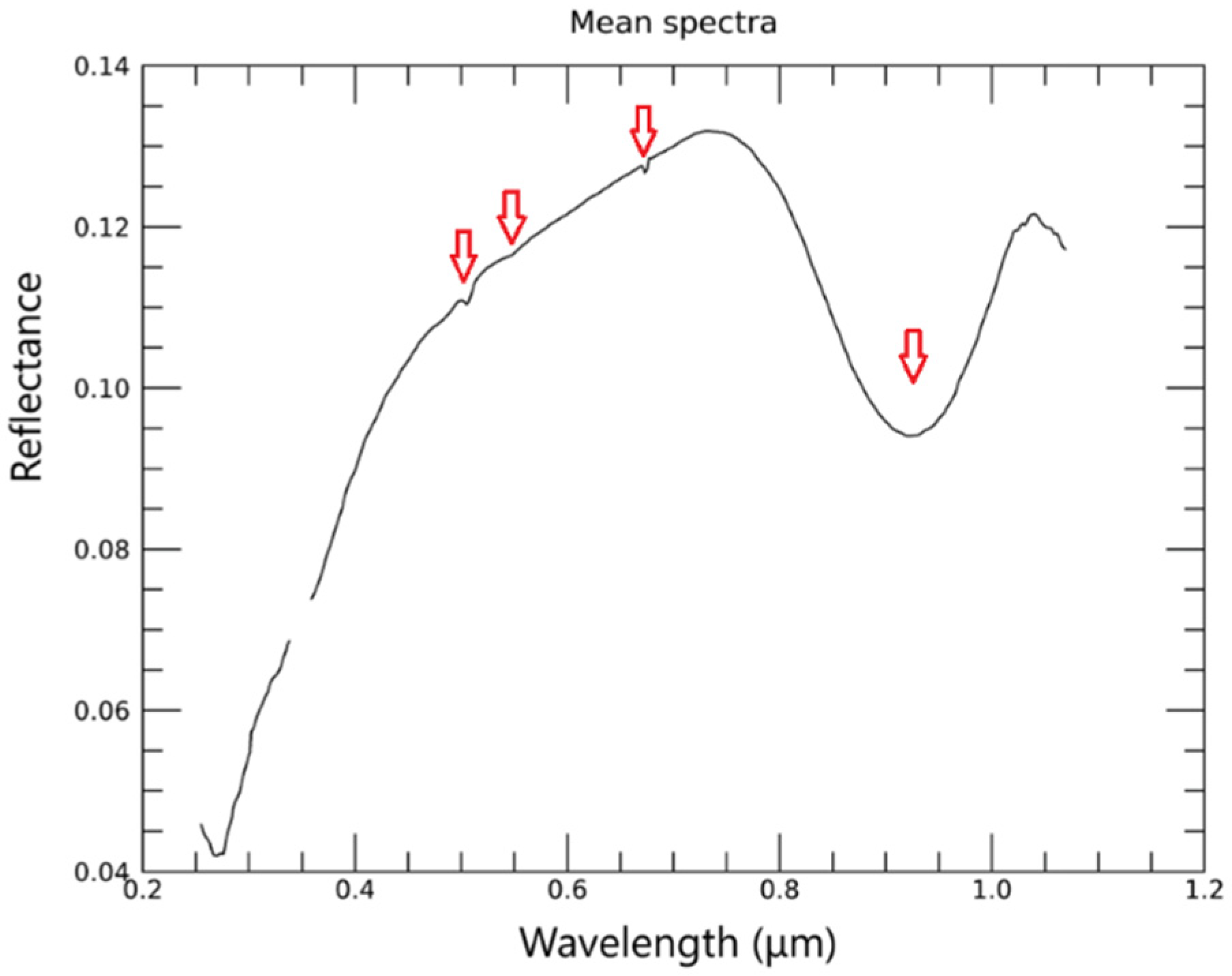

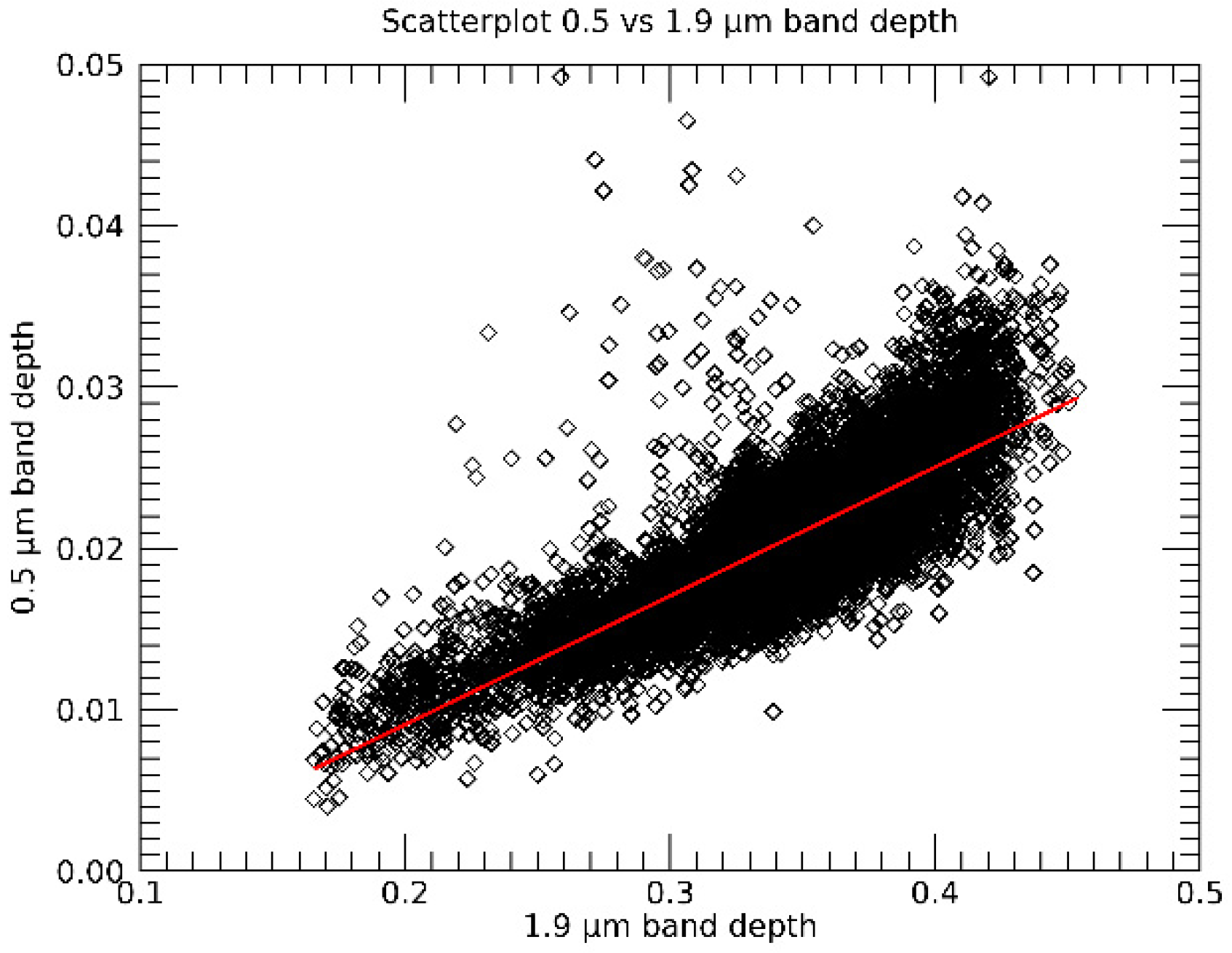
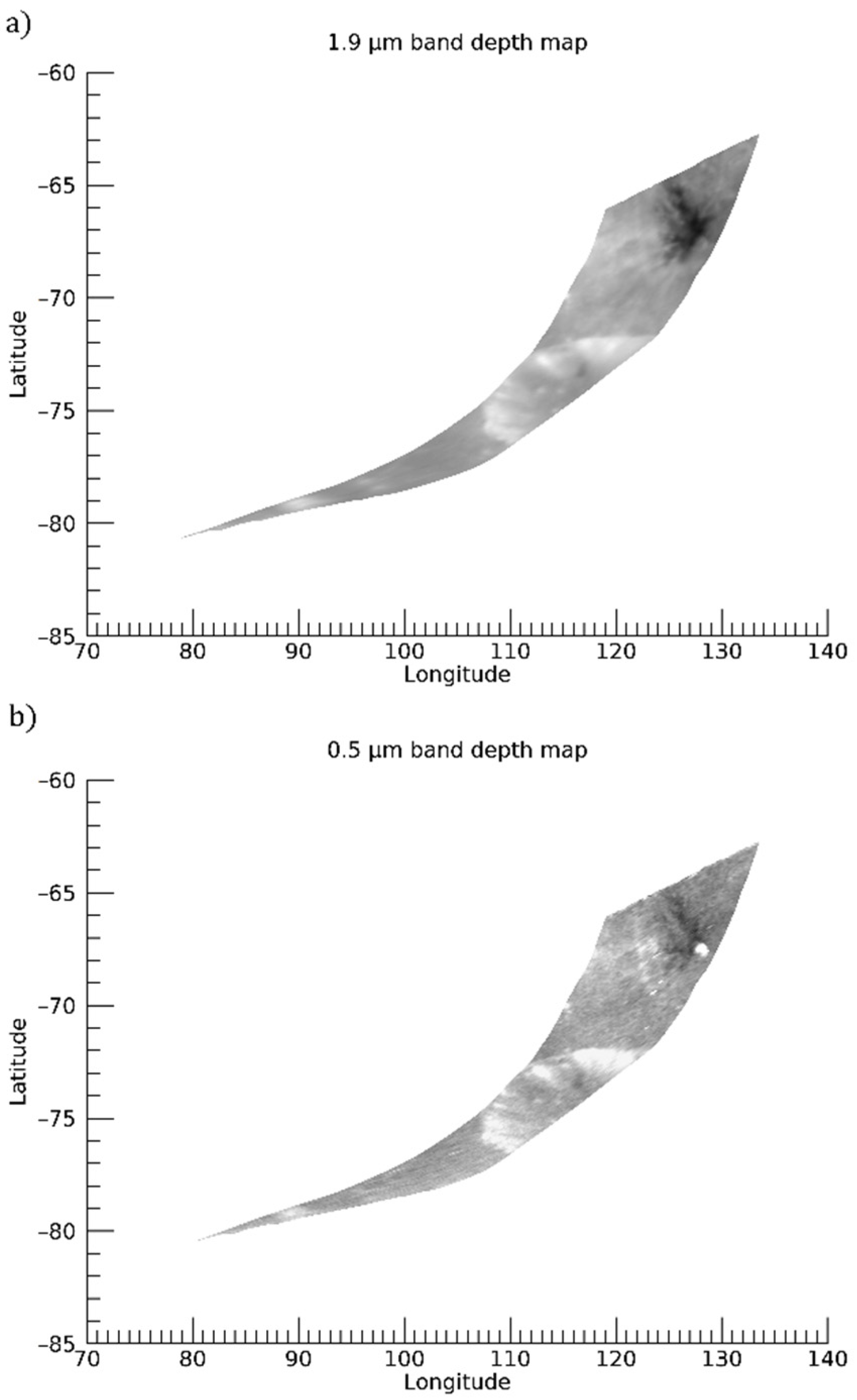


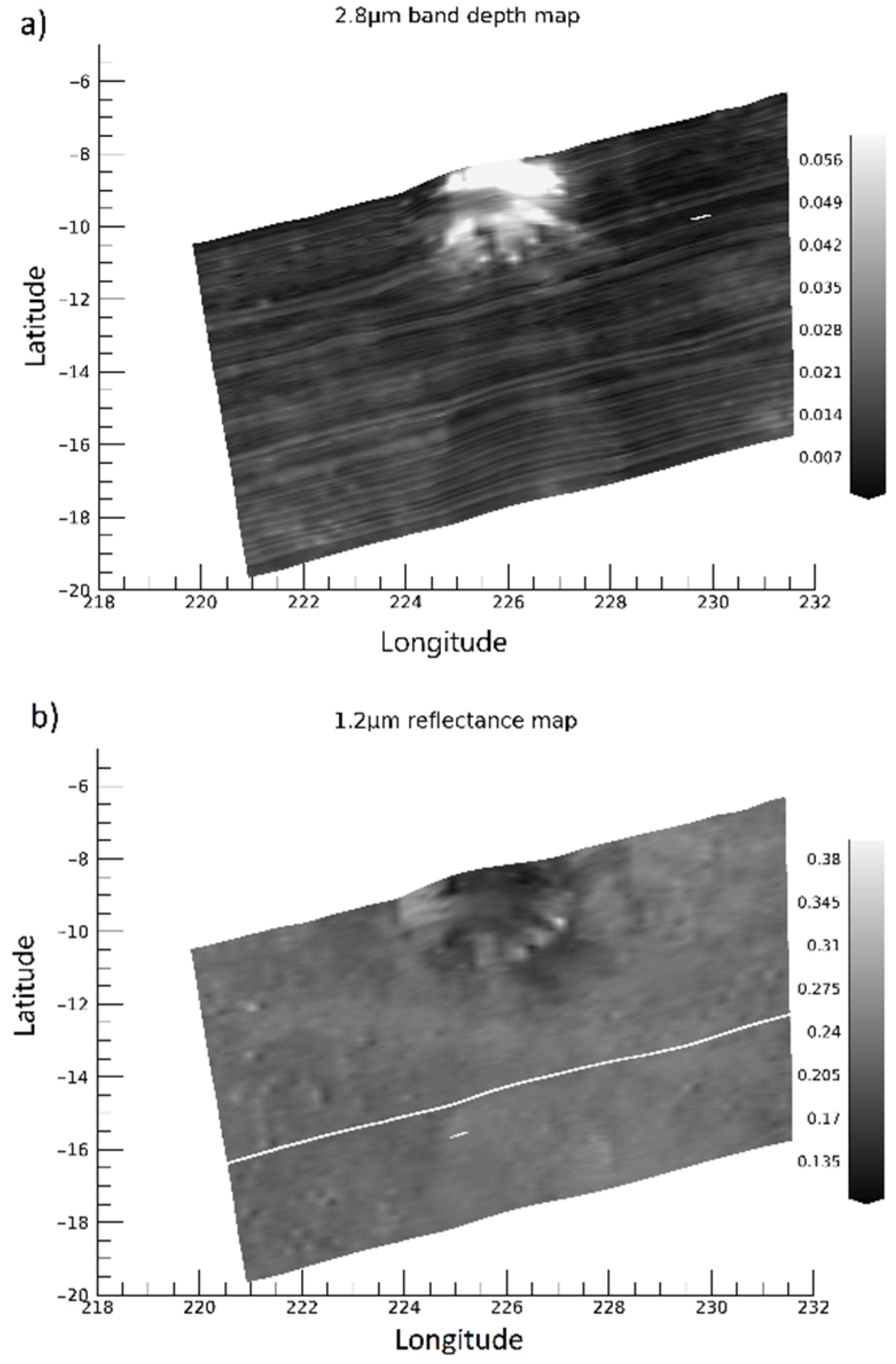
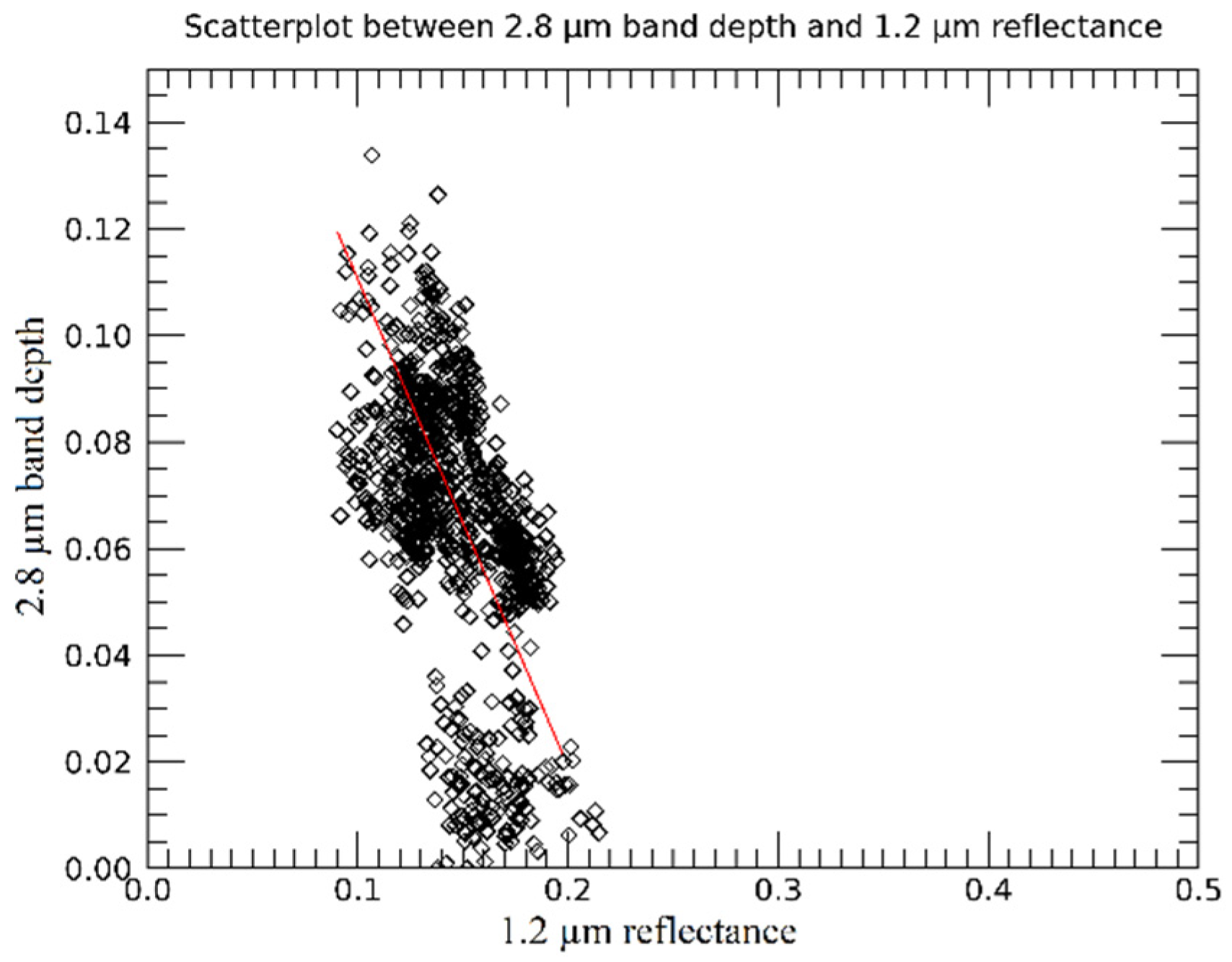
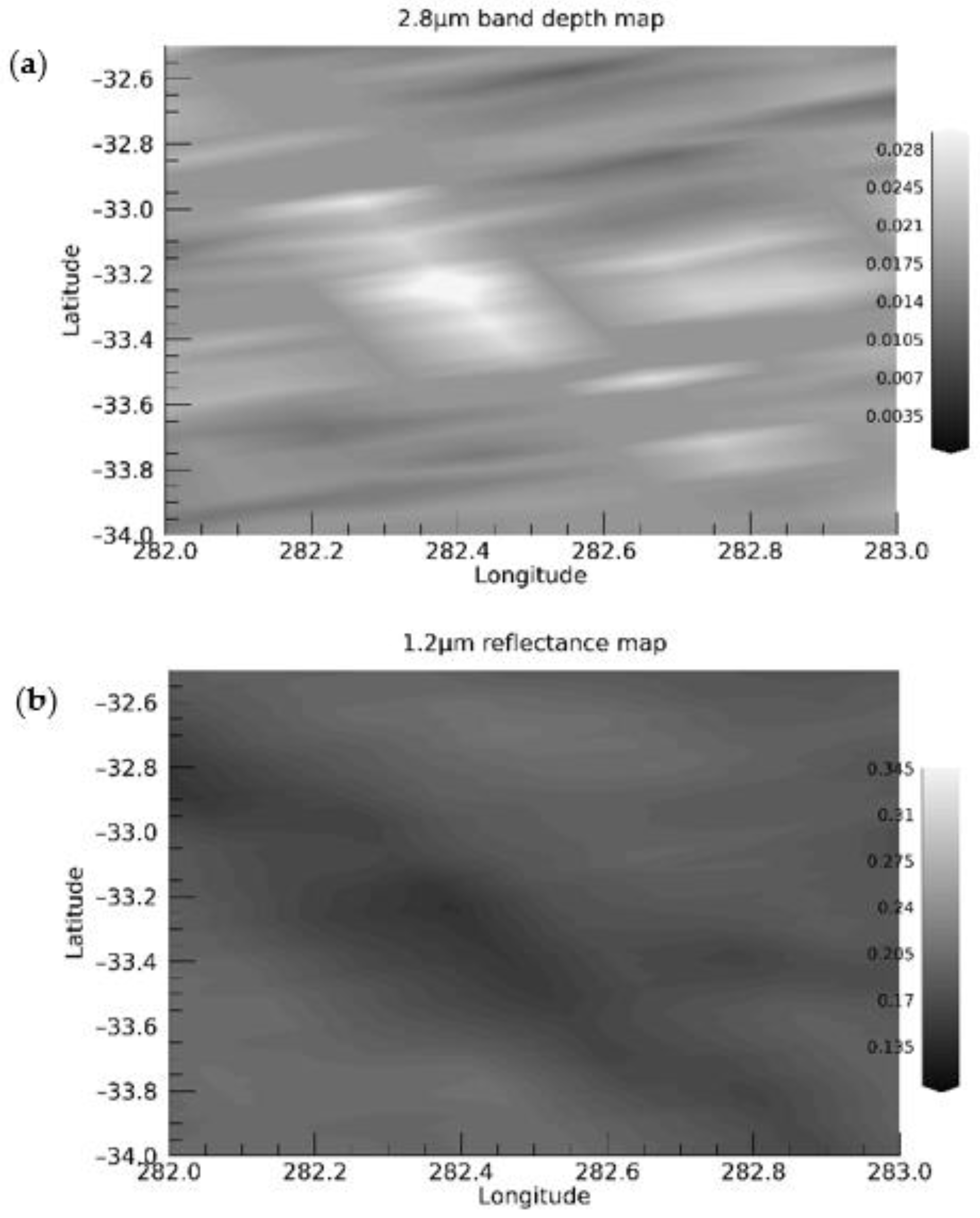
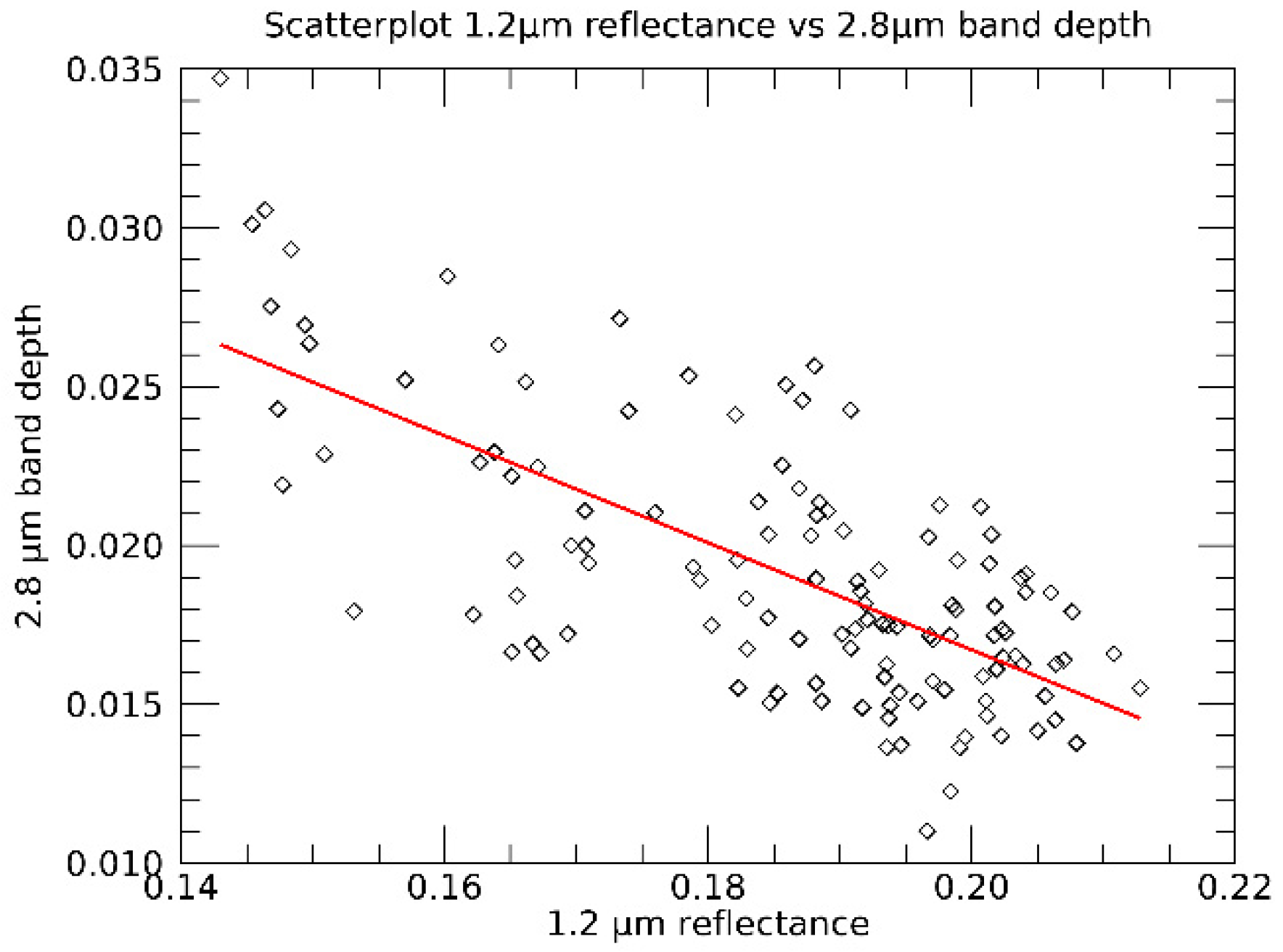
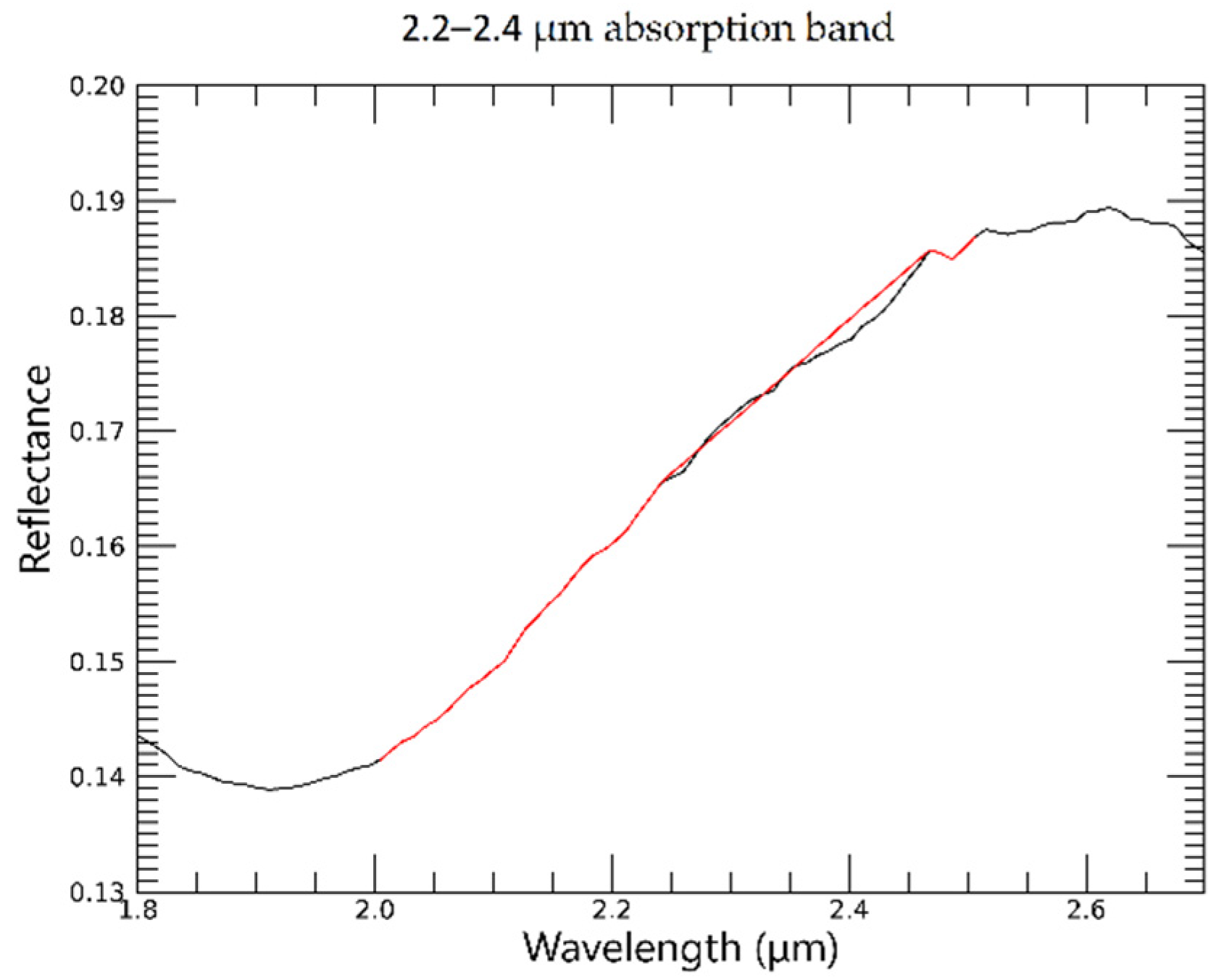
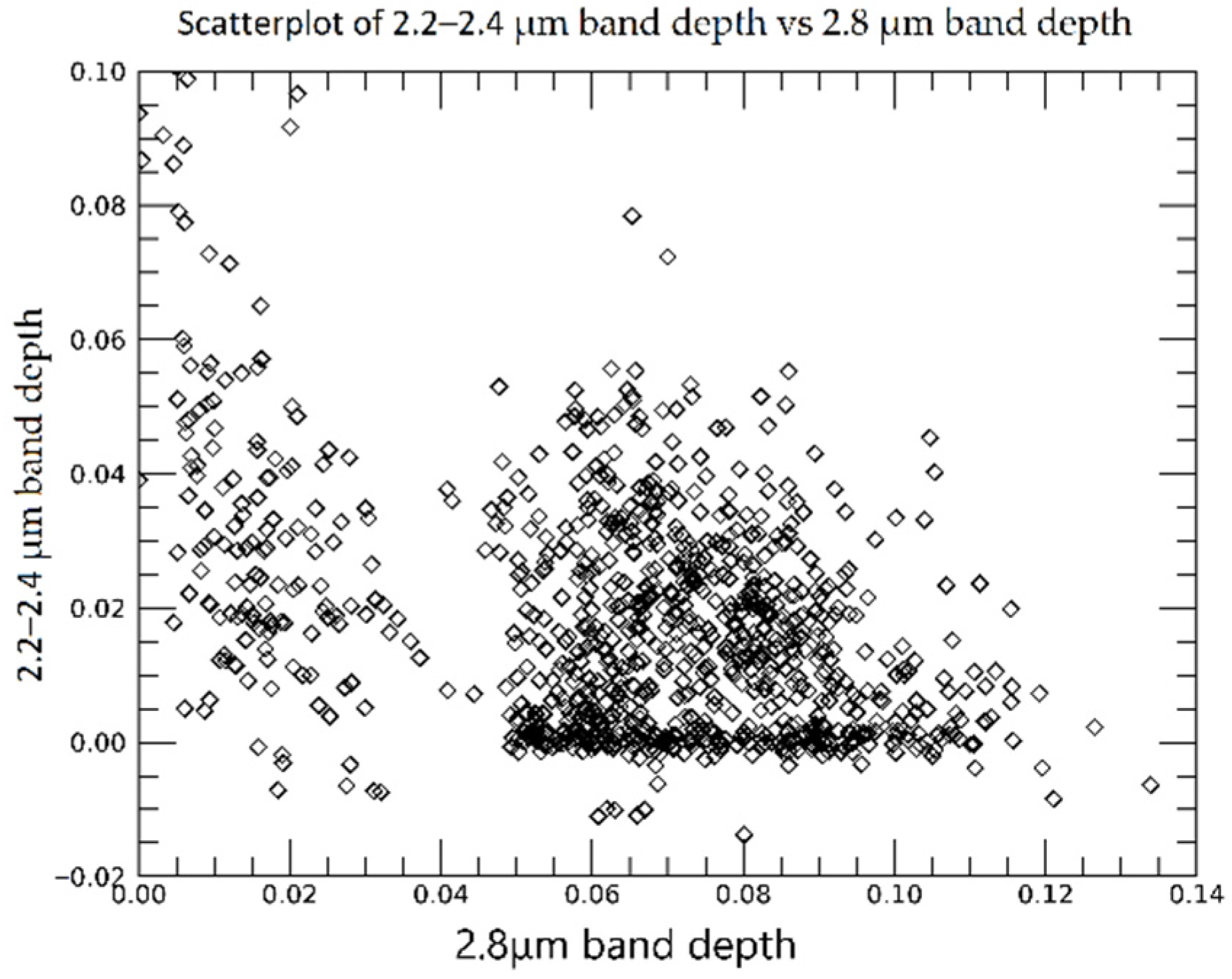
| Phase | Altitude (km) | Lat (°) | Pixel Resolution (km) |
|---|---|---|---|
| Approach | 2707–5497 | 70.0 S–59.2 N | 0.677–1.374 |
| Survey | 2704–2874 | 90.0 S–44.6 N | 0.676–0.719 |
| Hamo | 660–820 | 82.9 S–45.8 N | 0.165–0.205 |
| Lamo | 172–298 | 90.0 S–26.1 N | 0.043–0.075 |
| Hamo-2 | 644–825 | 80.9 S–70.7 N | 0.161–0.206 |
Disclaimer/Publisher’s Note: The statements, opinions and data contained in all publications are solely those of the individual author(s) and contributor(s) and not of MDPI and/or the editor(s). MDPI and/or the editor(s) disclaim responsibility for any injury to people or property resulting from any ideas, methods, instructions or products referred to in the content. |
© 2023 by the authors. Licensee MDPI, Basel, Switzerland. This article is an open access article distributed under the terms and conditions of the Creative Commons Attribution (CC BY) license (https://creativecommons.org/licenses/by/4.0/).
Share and Cite
Massa, G.; Longobardo, A.; Palomba, E.; Angrisani, M.; Gisellu, C.; Dirri, F.; De Sanctis, M.C.; Raponi, A.; Carrozzo, F.G.; Ciarniello, M. Pyroxene and Hydroxyl Signatures in Vesta Newly Calibrated Data from Dawn Mission. Universe 2023, 9, 296. https://doi.org/10.3390/universe9060296
Massa G, Longobardo A, Palomba E, Angrisani M, Gisellu C, Dirri F, De Sanctis MC, Raponi A, Carrozzo FG, Ciarniello M. Pyroxene and Hydroxyl Signatures in Vesta Newly Calibrated Data from Dawn Mission. Universe. 2023; 9(6):296. https://doi.org/10.3390/universe9060296
Chicago/Turabian StyleMassa, Giuseppe, Andrea Longobardo, Ernesto Palomba, Marianna Angrisani, Chiara Gisellu, Fabrizio Dirri, Maria Cristina De Sanctis, Andrea Raponi, Filippo Giacomo Carrozzo, and Mauro Ciarniello. 2023. "Pyroxene and Hydroxyl Signatures in Vesta Newly Calibrated Data from Dawn Mission" Universe 9, no. 6: 296. https://doi.org/10.3390/universe9060296
APA StyleMassa, G., Longobardo, A., Palomba, E., Angrisani, M., Gisellu, C., Dirri, F., De Sanctis, M. C., Raponi, A., Carrozzo, F. G., & Ciarniello, M. (2023). Pyroxene and Hydroxyl Signatures in Vesta Newly Calibrated Data from Dawn Mission. Universe, 9(6), 296. https://doi.org/10.3390/universe9060296










